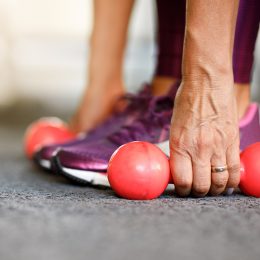Exercise After an Injury: 6 Tips to Bounce Back Faster
Experts share how the right training plan can speed up your recovery.

In an ideal world, we’d all take measures to prevent injuries from happening in the first place. In reality, accidents happen. And when they do, it’s common to be told to take a break from exercise and follow the RICE technique: rest, ice, compression, and elevation.
But there’s evidence that the right training plan may help you recover from an injury faster. Case in point: A study published in The New England Journal of Medicine found that starting a rehab program just two days after an injury helped recreational athletes return to their normal activity level three weeks faster than those who waited nine days to start their rehab. And neither group had a higher risk of reinjury.
“The right training plan can help you recover faster by aiding in increased blood flow to the affected area, which will promote accelerated healing,” says Sam Becourtney, D.P.T., C.S.C.S., a physical therapist at Bespoke Treatments in New York City.
Meanwhile, stopping exercise completely can limit blood flow to the injured area, causing the muscles to tighten up and eventually weaken. Later, when you decide to restart your exercise routine, you may find that it’s harder to regain your strength and range of motion.
“Plus, when we’re completely sedentary, we don’t get that release of feel-good endorphins we normally get during exercise,” Becourtney says. “With fewer of these pain-relieving chemicals circulating around our bodies, our injuries may feel even more painful.”
It’s also important to note that halting your exercise routine affects more than just the site of your injury. “One of the biggest mistakes folks make when they injure a body part is to completely rest their full body — their heart, lungs, and brain. This is like getting one flat tire and slashing the other three,” says Nick Occhipinti, C.S.C.S., a sports chiropractor and strength coach based in New Jersey. With a few exceptions (more on those below), most injuries can be trained around, he says.
Stay active, have fun, get fit — with SilverSneakers! Classes and events are happening right now at participating gyms, online through SilverSneakers LIVE, and at community centers near you. Activate your free online account to get started.
When Total Rest Is Best
“There are certainly situations when it truly is best to rest, although they’re not as common as many people think,” Becourtney says. For example, if an injury was caused by overuse or not allowing your body to adequately recover between exercise sessions, it makes sense to give your body time to rest.
Common signs of an overuse injury include pain, swelling, stiffness, and sometimes tingling or numbness. Symptoms usually worsen during specific activities and improve with rest, but if they don’t, talk with your doctor or physical therapist. Pain is your body’s way of telling you something is off, so don’t ignore it.
After a surgery, your physician may recommend limiting your physical activity, especially when certain movements may interfere with your bones’ or tissues’ ability to repair. “Injuries such as a fracture or tear may require a short resting time to allow for pain and inflammation to calm down before you begin physical therapy,” says Ashley Adamczyk, D.P.T., a senior physical therapist at Rush University Medical Center.
Head trauma of any kind may also warrant full rest. As always, talk to your doctor and follow the protocol they give you. In post-surgical or trauma situations, recovery isn’t one size fits all.
6 Tips for Staying Active (and Safe) While You Heal
Once your doctor or physical therapist clears you for exercise, follow these tips to return safely — and ultimately stronger than ever.
Recovery Tip #1: Never Push Through Pain
Soreness during exercise is normal when you’re recovering from an injury, but pain is not. Never adopt the mentality that you just need to “push through.”
Becourtney recommends ranking your pain on a 10-point scale, with zero being no pain at all and 10 being the worst possible pain. Ease up or stop exercising if your pain hits a 3 or 4. That will help you avoid overusing injured tissues in a way that negatively impacts recovery, he says.
Recovery Tip #2: Experiment with Small Adjustments
If you feel discomfort or pain during exercise, change the movement slightly to see if that alleviates the issue. Sometimes changing your grip, foot position, incline, range of motion, and/or weight can quickly eliminate pain.
For example, if you feel knee pain during lunges, try taking a longer stance, meaning you step farther forward during forward lunges or farther backward during back lunges. This will allow you to shift more of your weight to your hips, engaging your glutes, hamstrings, and back — taking some of the load off the front knee.
If small adjustments don’t help, Occhipinti suggests removing that exercise from your workout. That doesn’t mean you’ll never do it again; just wait until it no longer causes discomfort.
Recovery Tip #3: If You Can’t Use One Limb, Work the Other
Even if you can’t use one of your limbs, you can still see recovery benefits by training the one that isn’t in pain. According to a review in the Journal of Science and Medicine in Sport, strengthening one limb at a time can actually transfer strength to the opposite limb, helping you maintain function even when your limb is immobilized. This may speed up your recovery.
Subscribe to our newsletter
It's quick and easy. You could be one of the 13 million people who are eligible.
Already a member? Click to discover our 15,000+ participating locations.
Follow Us
Recovery Tip #4: Go Easy on Yourself
It’s normal to lose strength and fitness when dealing with an injury, “and it can be frustrating to try to get back into things and not be able to do the same things you’re used to,” Occhipinti says.
Beating yourself up about it doesn’t help. “Take it slow and chase small victories based on consistency, exercising pain-free, and trying new things while working back up to your pre-injury levels of strength and fitness,” he says.
Recovery Tip #5: Avoid High-Impact Exercise
Depending on your injury, you may want to avoid high-impact exercises like jumping or running, as these can increase stress on an injured joint or soft tissue structure and delay the healing process, Adamczyk says.
As you progress in your recovery, you can gradually add moderate- and then high-impact activities back into your routine, but the timeline is different for everyone. Work with your physical therapist and take note of any pain or discomfort.
Recovery Tip #6: Plan to Progress Slowly
Speaking of timelines, don’t always expect to bounce back quickly. Instead, consider all the variables that go into exercise: frequency, intensity, and duration. To progress safely, increase only one variable at a time, Becourtney says.
For example, if you increase your walking pace one week, that’s not the week to also increase your distance. Save that goal for next week.
Check Your SilverSneakers Eligibility Instantly
SilverSneakers members can go to thousands of nationwide gyms and fitness locations, plus take SilverSneakers LIVE online classes that are designed for all fitness levels and abilities. If you have a Medicare Advantage plan, it may include SilverSneakers — at no additional cost. Check your eligibility instantly here.
Already a member? Get your SilverSneakers member ID and exclusive fitness and wellness content by activating your online account here.
Not eligible for SilverSneakers? You can still get 200+ free SilverSneakers On-Demand videos and stay in touch with us by creating your online account.




